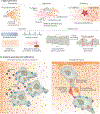The principles of directed cell migration
- PMID: 33990789
- PMCID: PMC8663916
- DOI: 10.1038/s41580-021-00366-6
The principles of directed cell migration
Abstract
Cells have the ability to respond to various types of environmental cues, and in many cases these cues induce directed cell migration towards or away from these signals. How cells sense these cues and how they transmit that information to the cytoskeletal machinery governing cell translocation is one of the oldest and most challenging problems in biology. Chemotaxis, or migration towards diffusible chemical cues, has been studied for more than a century, but information is just now beginning to emerge about how cells respond to other cues, such as substrate-associated cues during haptotaxis (chemical cues on the surface), durotaxis (mechanical substrate compliance) and topotaxis (geometric features of substrate). Here we propose four common principles, or pillars, that underlie all forms of directed migration. First, a signal must be generated, a process that in physiological environments is much more nuanced than early studies suggested. Second, the signal must be sensed, sometimes by cell surface receptors, but also in ways that are not entirely clear, such as in the case of mechanical cues. Third, the signal has to be transmitted from the sensing modules to the machinery that executes the actual movement, a step that often requires amplification. Fourth, the signal has to be converted into the application of asymmetric force relative to the substrate, which involves mostly the cytoskeleton, but perhaps other players as well. Use of these four pillars has allowed us to compare some of the similarities between different types of directed migration, but also to highlight the remarkable diversity in the mechanisms that cells use to respond to different cues provided by their environment.
© 2021. Springer Nature Limited.
Conflict of interest statement
Competing interests
The authors declare no competing interests.
Figures




Similar articles
-
Durotaxis: the mechanical control of directed cell migration.FEBS J. 2022 May;289(10):2736-2754. doi: 10.1111/febs.15862. Epub 2021 May 7. FEBS J. 2022. PMID: 33811732 Free PMC article. Review.
-
All Roads Lead to Directional Cell Migration.Trends Cell Biol. 2020 Nov;30(11):852-868. doi: 10.1016/j.tcb.2020.08.002. Epub 2020 Aug 29. Trends Cell Biol. 2020. PMID: 32873438 Review.
-
Directed cell migration in multi-cue environments.Integr Biol (Camb). 2013 Nov;5(11):1306-23. doi: 10.1039/c3ib40137e. Epub 2013 Oct 3. Integr Biol (Camb). 2013. PMID: 24089107 Review.
-
Mechanical guidance of cell migration: lessons from chemotaxis.Curr Opin Cell Biol. 2013 Oct;25(5):543-9. doi: 10.1016/j.ceb.2013.04.010. Epub 2013 May 28. Curr Opin Cell Biol. 2013. PMID: 23726023 Review.
-
Review series: TOR kinase complexes and cell migration.J Cell Biol. 2011 Sep 19;194(6):815-24. doi: 10.1083/jcb.201102090. J Cell Biol. 2011. PMID: 21930774 Free PMC article. Review.
Cited by
-
Piezo1 - Serine/threonine-protein phosphatase 2A - Cofilin1 biochemical mechanotransduction axis controls F-actin dynamics and cell migration.Heliyon. 2024 Jun 5;10(11):e32458. doi: 10.1016/j.heliyon.2024.e32458. eCollection 2024 Jun 15. Heliyon. 2024. PMID: 38933959 Free PMC article.
-
Keratocytes migrate against flow with a roly-poly-like mechanism.Proc Natl Acad Sci U S A. 2022 Nov 29;119(48):e2210379119. doi: 10.1073/pnas.2210379119. Epub 2022 Nov 21. Proc Natl Acad Sci U S A. 2022. PMID: 36409912 Free PMC article.
-
Individual cells generate their own self-reinforcing contact guidance cues through local matrix fiber remodeling.PLoS One. 2022 Mar 25;17(3):e0265403. doi: 10.1371/journal.pone.0265403. eCollection 2022. PLoS One. 2022. PMID: 35333902 Free PMC article.
-
Targeted Single-cell Isolation of Spontaneously Escaping Live Melanoma Cells for Comparative Transcriptomics.Cancer Res Commun. 2023 Aug 11;3(8):1524-1537. doi: 10.1158/2767-9764.CRC-22-0305. eCollection 2023 Aug. Cancer Res Commun. 2023. PMID: 37575281 Free PMC article.
-
ArfGAP1 regulates the endosomal sorting of guidance receptors to promote directed collective cell migration in vivo.iScience. 2023 Jul 25;26(8):107467. doi: 10.1016/j.isci.2023.107467. eCollection 2023 Aug 18. iScience. 2023. PMID: 37599820 Free PMC article.
References
-
- Janssen E & Geha RS Primary immunodeficiencies caused by mutations in actin regulatory proteins. Immunol. Rev. 287, 121–134 (2019). - PubMed
Publication types
MeSH terms
Grants and funding
LinkOut - more resources
Full Text Sources
Other Literature Sources

